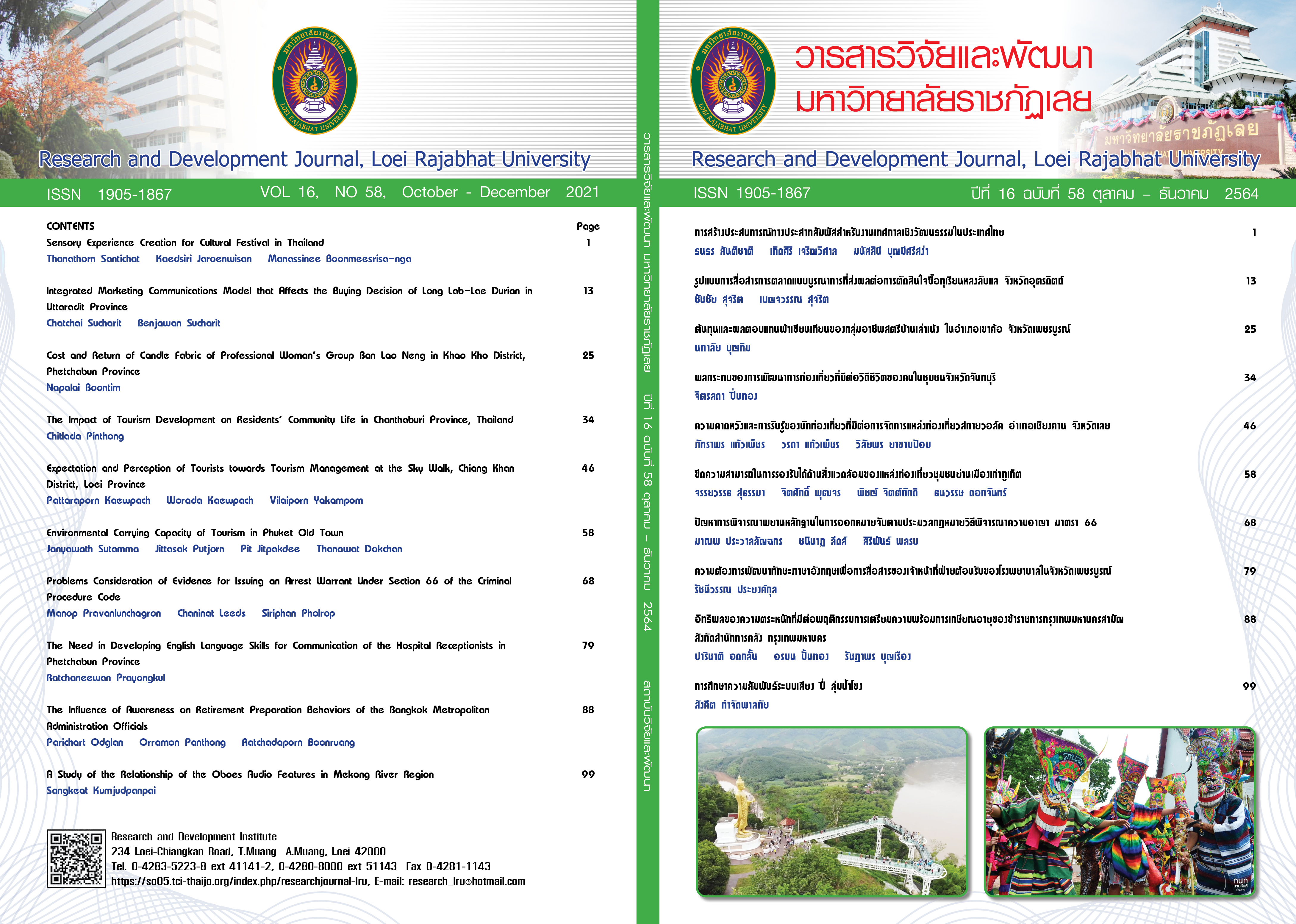Environmental Carrying Capacity of Tourism in Phuket Old Town
Keywords:
tourism carrying capacity, environment, participation, sustainable tourismAbstract
This research aims to study about the tourism carrying capacity of Phuket Old Town, and to establish measures for sustainable tourism management. This research was conducted using mixed-method approach by employing interviews, focus groups, observation, survey, and evaluation with communal leaders and members and government and private sector for the qualitative data before conducted the content analysis. As for the quantitative data, the researchers employed questionnaires to study frequency, percentage, and means. The study results suggested that there was garbage overcapacity with the number of 0.8 kilograms per person per day, as well as the quality of tab water that had been indicated as contaminated, and noise pollution in public areas was also needed to be managed especially upon the weekly opening hours of the Lad Yai market. The measures applied by the local community: 1) in order to reduce garbage, the community urged and gathered collaboration from the local businesses to avoid using materials that could become garbage, while introducing the reused or natural products, and collaborated with the municipality in terms of waste management; and 2) the community coordinated and worked together with the Phuket municipality and the provincial public health office to improve tap water quality.
References
กรมพัฒนาชุมชน. (2562, 30 ตุลาคม). การจัดประเภทชุมชนท่องเที่ยว OTOP นวัตวิถี. สืบค้นจาก https://cep.cdd.go.th/otop-นวัตวิถี/การจัดประเภทชุมชนท่องเที่ยว.
กิตติ อริยานน์. (2548). การวิจัยเชิงปฏิบัติการแบบมีส่วนร่วมเพื่อการพัฒนาการท่องเที่ยวที่ยั่งยืน กรณีศึกษาอุทยานสิ่งแวดล้อมนานาชาติสิรินธร ตำบลชะอำ อำเภอชะอำ จังหวัดเพชรบุรี (วิทยานิพนธ์ปริญญาดุษฎีบัณฑิต). มหาวิทยาลัยมหิดล, นครปฐม.
จิราภา ปราเดรา ดิเอส, พรรณนิภา ดอกไม้งาน, ปเนต มโนมัยวิบูลย์, ชัชชญา ยอดสุวรรณ และอภิสม อินทรลาวัลย์. (2561). มองรู้ ดูออก บอกต่อ การจัดทำชุดความรู้และกระบวนการจัดการความรู้เพื่อพัฒนาเทคนิค การปฏิบัติงานของ อพท. ตามแนวทางของหลักเกณฑ์ GSTC (Global Sustainable Tourism Criteria). กรุงเทพฯ: บริษัท ภูมิปัญญาไทยพัฒนา จำกัด.
บัณฑร อ่อนดำ. (2536). กระบวนการปรับปรุง และพัฒนากลุ่มองค์กรประชาชนเชียงใหม่. เชียงใหม่: มหาวิทยาลัยเชียงใหม่.
วรินทร์ สังข์ทอง และอารีย์ฏา ถิรสัตยาพิทักษ์. (2562). การมีส่วนร่วมของประชาชนในการจัดการท่องเที่ยวอย่ำงยั่งยืน: กรณีศึกษาย่านเมืองเก่าภูเก็ต. วารสารการการท่องเที่ยวไทยนานาชาติ, 15(1), 10-21.
วิภาดา ศุภรัฐปรีชา. (2553). ผลกระทบจากการท่องเที่ยวต่อสังคมและวัฒนธรรมในชุมชนวัดเกต เชียงใหม่. กรุงเทพฯ: จุฬาลงกรณ์มหาวิทยาลัย.
เทียมสูรย์ สิริศรีศักดิ์ และกฤษณะ แพทย์จะเกร็ง. (2561). ปริทัศน์สถานภาพความรู้ เรื่องความเหลื่อมล้ำในเมืองท่องเที่ยว. วารสารสังคมวิทยาและมานุษยวิทยา, 44(1). 41-46.
Downloads
Published
How to Cite
Issue
Section
License
ข้อความที่ปรากฎในวารสารฉบับนี้เป็นความคิดเห็นของผู้เขียนแต่ละท่าน สถาบันวิจัยและพัฒนา มหาวิทยาลัยราชภัฏเลย และกองบรรณาธิการ ไม่จำเป็นต้องเห็นด้วยและไม่มีส่วนรับผิดชอบใดๆ
สถาบันวิจัยและพัฒนา มหาวิทยาลัยราชภัฏเลย ขอให้ผู้อ่านอ้างอิงในกรณีที่ท่านคัดลอกเนื้อหาบทความในวารสารฉบับนี้






